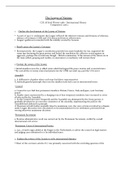Tentamen (uitwerkingen)
League of Nations complete summary - component 1 International History 9489/9389
- Instelling
- CIE
In this document I offer you questions and answers regarding component 1 - International History AS level - League of Nations. If you are aiming for an A/A* you will find a lot of useful details to include in your essays. I provide you with a sustained judgement with both pro's and cons! ...
[Meer zien]




